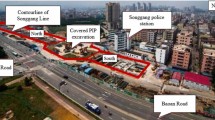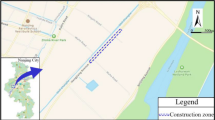Abstract
Through the field inspection, this study investigated the performance of a deep foundation pit supported by suspended piles in soil and rock strata for a subway station in Qingdao Metro Line 3 in China. A large number of site-measured data are analyzed to investigate the settlement of ground surface and pile top, the horizontal displacement of pile and soil at different depths, and the relations between pile displacement and surface settlement under different construction stages. The deformation mechanism and the various influencing factors are discussed. Results showed that the blasting excavation of rock stratum has a great disturbance on the surface settlement outside the pit. The construction of the upper steel pipe support can effectively reduce the influence of disturbance, and the application of lock bolt support with shotcrete below the soil-rock interface can enable the surface settlement rate to be stable. When the foundation bottom reinforced concrete is completed, the ground surface settlement at different measuring points stabilizes in the range of 7~9mm. At the blasting excavation site, the maximum ground surface settlement accounts for 0.051% of the excavation depth. The ratio of maximum pile final lateral displacement to the final ground surface settlement is 1.43. The maximum ground surface settlement accounts for 0.058% of the excavation depth. The ratio of maximum horizontal displacement of soil to the final ground surface settlement is 0.7. Besides, the excavation of the upper soil layers of the foundation pit will result in the soil unloading and sublayer rebound, thus driving the uplift of the pile. The excavation of the lower rock layer influences the overall stability of the bored pile, and the construction of the steel pipe support and the anchor cable can effectively offset this effect. Although the horizontal displacement value is about 6 mm, it still cannot be ignored when compared with the overall lateral shift. When the bottom concrete slab is built, the maximum lateral displacement of the pile is located near the soil-rock interface.













Similar content being viewed by others
References
Alipour A, Eslami A (2019) Design adaptations in a large and deep urban excavation: case study. J Rock Mech Geotech Eng 11(2):389–399. https://doi.org/10.1016/j.jrmge.2018.08.014
Cañavate-Grimal A, Falcó A, Calderón P, Payá-Zaforteza I (2015) On the use of stochastic spectral methods in deep excavation inverse problems. Comput Struct 159((C)):41–60. https://doi.org/10.1016/j.compstruc.2015.06.009
Cao R, Cao P, Lin H (2016) Support technology of deep roadway under high stress and its application. Int J Min Sci Technol 26(5):787–793. https://doi.org/10.1016/j.ijmst.2016.05.046
Comodromos EM, Papadopoulou MC, Georgiadis K (2018) Design procedure for the modelling of jet-grout column slabs supporting deep excavations. Comput Geotech 100:110–120. https://doi.org/10.1016/j.compgeo.2018.04.008
Cui X, Ye M, Zhuang Y (2018) Performance of a foundation pit supported by bored piles and steel struts: a case study. Soils Found 58(4):1016–1027. https://doi.org/10.1016/j.sandf.2018.05.004
Dashti S, Hashash Y, Gillis K, Musgrove M, Walker M (2016) Development of dynamic centrifuge models of underground structures near tall buildings. Soil Dyn Earthq Eng 86:89–105. https://doi.org/10.1016/j.soildyn.2016.04.014
Do TN, Ou CY, Chen RP (2016) A study of failure mechanisms of deep excavations in soft clay using the finite element method. Comput Geotech 73:153–163. https://doi.org/10.1016/j.compgeo.2015.12.009
Farzi M, Pakbaz MS, Aminpour HA (2018) Selection of support system for urban deep excavations: a case study in Ahvaz geology. Case Stud Constr Mater 8(2108):131–138. https://doi.org/10.1016/j.cscm.2018.01.004
Feng S, Wu Y, Li J, Li P, Zhang Z, Wang D (2012) The analysis of spatial effect of deep foundation pit in soft soil areas. Procedia Earth Planet Sci 5((none)):309–313. https://doi.org/10.1016/j.proeps.2012.01.052
Feng T, Liu L, Tong T, Zhou M (2017) Numerical study on lateral wall displacement of deep excavation supported by IPS earth retention system. Undergr Space 2(4):259–271. https://doi.org/10.1016/j.undsp.2017.09.001
Guo P, Gong X, Wang Y (2019) Displacement and force analyses of braced structure of deep excavation considering unsymmetrical surcharge effect. Comput Geotech 113:103102
Hsiung BCB (2009) A case study on the behaviour of a deep excavation in sand. Comput Geotech 36(4):665–675. https://doi.org/10.1016/j.compgeo.2008.10.003
Hsiung BCB, Yang KH, Aila W, Ge L (2018) Evaluation of the wall deflections of a deep excavation in central Jakarta using three-dimensional modeling. Tunn Undergr Space Technol 72:84–96. https://doi.org/10.1016/j.tust.2017.11.013
Jia P, Yang TH, Yu QL (2012) Mechanism of parallel fractures around deep underground excavations. Theor Appl Fract Mech 61((Complete)):57–65. https://doi.org/10.1016/j.tafmec.2012.08.007
Khoiri M, Ou CY (2013) Evaluation of deformation parameter for deep excavation in sand through case histories. Computers and Geotechnics 47((none)):57–67. https://doi.org/10.1016/j.compgeo.2012.06.009
Khoiri M, Ou CY, Teng FC (2014) A comprehensive evaluation of strength and modulus parameters of a gravelly cobble deposit for deep excavation analysis. Eng Geol 174:61–72. https://doi.org/10.1016/j.enggeo.2014.03.008
Long M (2001) Database for retaining wall and ground movements due to deep excavations. J Geotech Geoenviron Eng 127(3):203–224. https://doi.org/10.1061/(asce)1090-0241(2001)127:3(203)
Lue Q, Chan CL, Low BK (2012) Probabilistic evaluation of ground-support interaction for deep rock excavation using artificial neural network and uniform design. Tunn Undergr Space Technol 32:1–18. https://doi.org/10.1016/j.tust.2012.04.014
Luo Z, Li Y, Zhou S, Di H (2018) Effects of vertical spatial variability on supported excavations in sands considering multiple geotechnical and structural failure modes. Comput Geotech 95:16–29. https://doi.org/10.1016/j.compgeo.2017.11.017
Mitew-Czajewska M (2019) A study of displacements of structures in the vicinity of deep excavation. Arch Civ Mech Eng 19(2):547–556. https://doi.org/10.1016/j.acme.2018.11.010
Nikolinakou MA, Whittle AJ, Savidis S, Schran U (2011) Prediction and interpretation of the performance of a deep excavation in Berlin sand. J Geotech Geoenviron Eng 137(11):1047–1061. https://doi.org/10.1061/(asce)gt.1943-5606.0000518
Ou CY, Hsieh PG, Lin YL (2013) A parametric study of wall deflections in deep excavations with the installation of cross walls. Comput Geotech 50((Complete)):55–65. https://doi.org/10.1016/j.compgeo.2012.12.009
Shi J, Fu Z, Guo W (2019) Investigation of geometric effects on three-dimensional tunnel deformation mechanisms due to basement excavation. Comput Geotech 106:108–116
Tan Y, Wang D (2013) Characteristics of a large-scale deep foundation pit excavated by the central-island technique in Shanghai soft clay. I: Bottom-up construction of the central cylindrical shaft. J Geotech Geoenviron Eng 139(11):1875–1893. https://doi.org/10.1061/(ASCE)GT.1943-5606.0000928
Wang X, Cai M (2015) Influence of wavelength-to-excavation span ratio on ground motion around deep underground excavations. Tunn Undergr Space Technol 49:438–453. https://doi.org/10.1016/j.tust.2015.06.004
Whittle AJ, Hashash YMA, Whitman RV (1993) Analysis of deep excavation in Boston. J Geotech Eng 119(1):69–90. https://doi.org/10.1061/(ASCE)0733-9410(1993)119:1(69)
Wu Y, Kang H, Wu J, Gao F (2011) Deformation and support of roadways subjected to abnormal stresses. Procedia Engineering 26((none)):665–674. https://doi.org/10.1016/j.proeng.2011.11.2221
Zuo JP, Wang RK, Wu AM, Yang L, Wang ZG (2012) Optimization support controlling large deformation of tunnel in deep mine based on discontinuous deformation analysis. Procedia Environ Sci 12:1045–1054. https://doi.org/10.1016/j.proenv.2012.01.386
Acknowledgements
The authors gratefully acknowledge the financial supports from the National Natural Science Foundation of China (Grant Nos. 51978315 and 41402251) and the Natural Science Foundation of Jiangsu Province (Grant No. BK20180934). The opinions, findings, conclusions, or recommendations expressed herein are those of the authors and do not necessarily represent the views of the sponsors.
Author information
Authors and Affiliations
Corresponding author
Ethics declarations
Conflict of interest
The authors declare that they have no competing interests.
Additional information
Responsible Editor: Zeynal Abiddin Erguler
Rights and permissions
About this article
Cite this article
Shen, Ys., Yin, J., Zhu, DS. et al. Performance of a deep foundation pit supported by suspended piles in soil and rock strata: a case study. Arab J Geosci 14, 2211 (2021). https://doi.org/10.1007/s12517-021-08606-x
Received:
Accepted:
Published:
DOI: https://doi.org/10.1007/s12517-021-08606-x




